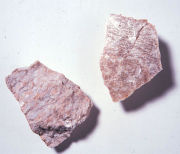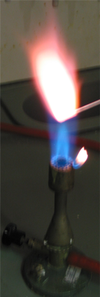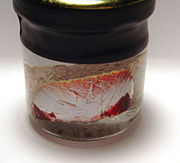Potassium
2008/9 Schools Wikipedia Selection. Related subjects: Chemical elements
|
|||||||||||||||||||||||||||||||
| General | |||||||||||||||||||||||||||||||
|---|---|---|---|---|---|---|---|---|---|---|---|---|---|---|---|---|---|---|---|---|---|---|---|---|---|---|---|---|---|---|---|
| Name, symbol, number | potassium, K, 19 | ||||||||||||||||||||||||||||||
| Chemical series | alkali metals | ||||||||||||||||||||||||||||||
| Group, period, block | 1, 4, s | ||||||||||||||||||||||||||||||
| Appearance | silvery white |
||||||||||||||||||||||||||||||
| Standard atomic weight | 39.0983 (1) g·mol−1 | ||||||||||||||||||||||||||||||
| Electron configuration | [Ar] 4s1 | ||||||||||||||||||||||||||||||
| Electrons per shell | 2, 8, 8, 1 | ||||||||||||||||||||||||||||||
| Physical properties | |||||||||||||||||||||||||||||||
| Phase | solid | ||||||||||||||||||||||||||||||
| Density (near r.t.) | 0.89 g·cm−3 | ||||||||||||||||||||||||||||||
| Liquid density at m.p. | 0.828 g·cm−3 | ||||||||||||||||||||||||||||||
| Melting point | 336.53 K (63.38 ° C, 146.08 ° F) |
||||||||||||||||||||||||||||||
| Boiling point | 1032 K (759 ° C, 1398 ° F) |
||||||||||||||||||||||||||||||
| Triple point | 336.35 K (63° C), kPa | ||||||||||||||||||||||||||||||
| Atomic properties | |||||||||||||||||||||||||||||||
| Crystal structure | cubic body centered | ||||||||||||||||||||||||||||||
| Oxidation states | 1 (strongly basic oxide) |
||||||||||||||||||||||||||||||
| Electronegativity | 0.82 (Pauling scale) | ||||||||||||||||||||||||||||||
| Ionization energies ( more) |
1st: 418.8 kJ·mol−1 | ||||||||||||||||||||||||||||||
| 2nd: 3052 kJ·mol−1 | |||||||||||||||||||||||||||||||
| 3rd: 4420 kJ·mol−1 | |||||||||||||||||||||||||||||||
| Atomic radius | 220 pm | ||||||||||||||||||||||||||||||
| Atomic radius (calc.) | 243 pm | ||||||||||||||||||||||||||||||
| Covalent radius | 196 pm | ||||||||||||||||||||||||||||||
| Van der Waals radius | 275 pm | ||||||||||||||||||||||||||||||
| Miscellaneous | |||||||||||||||||||||||||||||||
| Magnetic ordering | paramagnetic | ||||||||||||||||||||||||||||||
| Thermal conductivity | (300 K) 102.5 W·m−1·K−1 | ||||||||||||||||||||||||||||||
| Thermal expansion | (25 °C) 83.3 µm·m−1·K−1 | ||||||||||||||||||||||||||||||
| Speed of sound (thin rod) | (20 °C) 2000 m/s | ||||||||||||||||||||||||||||||
| Young's modulus | 3.53 GPa | ||||||||||||||||||||||||||||||
| Shear modulus | 1.3 GPa | ||||||||||||||||||||||||||||||
| Bulk modulus | 3.1 GPa | ||||||||||||||||||||||||||||||
| Mohs hardness | 0.4 | ||||||||||||||||||||||||||||||
| Brinell hardness | 0.363 MPa | ||||||||||||||||||||||||||||||
| CAS registry number | 7440-09-7 | ||||||||||||||||||||||||||||||
| Selected isotopes | |||||||||||||||||||||||||||||||
|
|||||||||||||||||||||||||||||||
| References | |||||||||||||||||||||||||||||||
Potassium (pronounced /pəˈtæsiəm/) is a chemical element. It has the symbol K (Arabic: al qalja → Latin: kalium) and atomic number 19. The name "potassium" comes from the word "potash", as potassium was first isolated from potash. Potassium is a soft silvery-white metallic alkali metal that occurs naturally bound to other elements in seawater and many minerals. It oxidizes rapidly in air and is very reactive, especially towards water. In many respects, potassium and sodium are chemically similar, although organisms in general, and animal cells in particular, treat them very differently.
Occurrence

Potassium metal is never found free, as it reacts violently with the abundant water in nature. As various compounds, potassium makes up about 1.5% of the weight of the Earth's crust and is the seventh most abundant element. As it is very electropositive, potassium metal is difficult to obtain from its minerals.
Potassium salts such as carnallite, langbeinite, polyhalite, and sylvite form extensive deposits in ancient lake and seabeds, making extraction of potassium salts in these environments commercially viable. The principal source of potassium, potash, is mined in Saskatchewan, California, Germany, New Mexico, Utah, and in other places around the world. Three thousand feet below the surface of Saskatchewan are large deposits of potash which are important sources of this element and its salts, with several large mines in operation since the 1960s. Saskatchewan pioneered the use of freezing of wet sands (the Blairmore formation) in order to drive mine shafts through them. The main mining company is the Potash Corporation of Saskatchewan. The oceans are another source of potassium, but the quantity present in a given volume of seawater is relatively low compared with sodium.
Production
Pure potassium metal can be isolated by electrolysis of its hydroxide in a process that has changed little since Davy. Thermal methods also are employed in potassium production, using potassium chloride.
Isotopes
There are 24 known isotopes of potassium. Three isotopes occur naturally: 39K (93.3%), 40K (0.0117%) and 41K (6.7%). Naturally occurring 40K decays to stable 40Ar (11.2%) by electron capture and by positron emission, and decays to stable 40Ca (88.8%) by beta decay; 40K has a half-life of 1.250×109 years. The decay of 40K to 40Ar enables a commonly used method for dating rocks. The conventional K-Ar dating method depends on the assumption that the rocks contained no argon at the time of formation and that all the subsequent radiogenic argon (i.e., 40Ar) was quantitatively retained. Minerals are dated by measurement of the concentration of potassium and the amount of radiogenic 40Ar that has accumulated. The minerals that are best suited for dating include biotite, muscovite, plutonic/high grade metamorphic hornblende, and volcanic feldspar; whole rock samples from volcanic flows and shallow instrusives can also be dated if they are unaltered.
Outside of dating, potassium isotopes have been used extensively as tracers in studies of weathering. They have also been used for nutrient cycling studies because potassium is a macronutrient required for life.
40K occurs in natural potassium (and thus in some commercial salt substitutes) in sufficient quantity that large bags of those substitutes can be used as a radioactive source for classroom demonstrations. In healthy animals and people, 40K represents the largest source of radioactivity, greater even than 14C. In a human body of 70 kg mass, about 4,400 nuclei of 40K decay per second.
The activity of natural potassium is 31 Bq/g.
Properties
Physical properties
Potassium is the second least dense metal; only lithium is less dense. It is a soft, low-melting solid that can easily be cut with a knife. Freshly cut potassium is silvery in appearance, but in air it begins to tarnish toward grey immediately.
In the flame test, potassium and its compounds emit a pale violet colour, which may be masked by the strong yellow emission of sodium if it is also present. Cobalt glass can be used to filter out the yellow sodium colour. Potassium concentration in solution is commonly determined by flame photometry, atomic absorption spectrophotometry, inductively coupled plasma, or ion selective electrodes.
Chemical properties
Potassium must be protected from air for storage to prevent disintegration of the metal from oxide and hydroxide corrosion. Often samples are maintained under a reducing medium such as kerosene.
Like the other alkali metals, potassium reacts violently with water, producing hydrogen. The reaction is notably more violent than that of lithium or sodium with water, and is sufficiently exothermic that the evolved hydrogen gas ignites.
- 2K(s) + 2H2O(l) → H2(g) + 2KOH(aq)
Because potassium reacts quickly with even traces of water, and its reaction products are nonvolatile, it is sometimes used alone, or as NaK (an alloy with sodium which is liquid at room temperature) to dry solvents prior to distillation. In this role, it serves as a potent desiccant.
Potassium hydroxide reacts strongly with carbon dioxide to produce potassium carbonate, and is used to remove traces of CO2 from air.
Potassium compounds generally have excellent water solubility, due to the high hydration energy of the K+ ion. The potassium ion is colorless in water.
Methods of separating potassium by precipitation, sometimes used for gravimetric analysis, include the use of sodium tetraphenyl boron, hexachloroplatinic acid, and sodium cobaltinitrite.
Potassium in the body
Biochemical function
Potassium is important in neuron (brain and nerve) function, and in influencing osmotic balance between cells and the interstitiual fluid.. Potassium is the major cation inside cells, in animals.
Potassium may be detected by taste because it triggers three of the five types of tastebuds, according to concentration. Dilute solutions of potassium ion taste sweet (allowing moderate concentrations in milk and juices), while higher concentrations become increasingly bitter/alkaline, and finally also salty to the taste. The combined bitterness and saltiness of high potassium content solutions makes high-dose potassium supplementation by liquid drinks a palatability challenge.
Membrane polarization
Potassium is also important in allowing muscle contraction and the sending of all nerve impulses in animals through action potentials. By nature of their electrostatic and chemical properties, K+ ions are larger than Na+ ions, and ion channels and pumps in cell membranes can distinguish between the two types of ions, actively pumping or passively allowing one of the two ions to pass, while blocking the other.
A shortage of potassium in body fluids may cause a potentially fatal condition known as hypokalemia, typically resulting from diarrhea, increased diuresis and vomiting. Deficiency symptoms include muscle weakness, paralytic ileus, ECG abnormalities, decreased reflex response and in severe cases respiratory paralysis, alkalosis and cardiac arrhythmia.
Filtration and excretion
Potassium is an essential mineral macronutrient in human nutrition; it is the major cation (positive ion) inside animal cells, and it is thus important in maintaining fluid and electrolyte balance in the body. Sodium makes up most of the cations of blood plasma at about 145 milliequivalents per liter (3345 milligrams) and potassium makes up most of the cell fluid cations at about 150 milliequivalents per liter (4800 milligrams). Plasma is filtered through the glomerulus of the kidneys in enormous amounts, about 180 liters per day. Thus 602,000 milligrams of sodium and 33,000 milligrams of potassium are filtered each day. All but the 1000-10,000 milligrams of sodium and the 1000-4000 milligrams of potassium likely to be in the diet must be reabsorbed. Sodium must be reabsorbed in such a way as to keep the blood volume exactly right and the osmotic pressure correct; potassium must be reabsorbed in such a way as to keep serum concentration as close as possible to 4.8 milliequivalents (about 190 milligrams) per liter. Sodium pumps must always operate to conserve sodium. Potassium must sometimes be conserved also, but since the amount of potassium in the blood plasma is very small and the pool of potassium in the cells is about thirty times as large, the situation is not so critical for potassium. Since potassium is moved passively in counter flow to sodium in response to an apparent (but not actual) Donnan equilibrium, the urine can never sink below the concentration of potassium in serum except sometimes by actively excreting water at the end of the processing. Potassium is secreted twice and reabsorbed three times before the urine reaches the collecting tubules. At that point, it usually has about the same potassium concentration as plasma. If potassium were removed from the diet, there would remain a minimum obligatory kidney excretion of about 200 mg per day when the serum declines to 3.0-3.5 milliequivalents per liter in about one week, and can never be cut off completely. Because it cannot be cut off completely, death will result when the whole body potassium declines to the vicinity of one-half full capacity. At the end of the processing, potassium is secreted one more time if the serum levels are too high.
The potassium moves passively through pores in the cell wall. When ions move through pumps there is a gate in the pumps on either side of the cell wall and only one gate can be open at once. As a result 100 ions are forced through per second. Pores have only one gate and there one kind of ion only can stream through at 10 million to 100 million ions per second. The pores require calcium in order to open although it is thought that the calcium works in reverse by blocking at least one of the pores. Carbonyl groups inside the pore on the amino acids mimics the water hydration that takes place in water solution by the nature of the electrostatic charges on four carbonyl groups inside the pore.
Potassium in the diet
Adequate intake can generally be guaranteed by eating a variety of foods containing potassium and deficiency is rare in healthy individuals eating a balanced diet. Foods with high sources of potassium include orange juice, potatoes, bananas, avocados, tomatoes, broccoli, soybeans and apricots, although it is also common in most fruits, vegetables and meats. Diets high in potassium can reduce the risk of hypertension and a potassium deficiency combined with an adequate thiamine intake has produced heart disease in rats. The 2004 guidelines of the Institute of Medicine specify an DRI of 4,000mg of potassium, though most Americans consume only half that amount per day. Similarly, in the European Union, particularly in Germany and Italy, insufficient potassium intake is somewhat common.
Supplements of potassium in medicine are most widely used in conjunction with loop diuretics and thiazides, classes of diuretics which rid the body of sodium and water, but have the side effect of also causing potassium loss in urine. A variety of medical supplements are available. If potassium supplements are used, such as sodium free baking powder and sodium free table salt, inadequate thiamine can cause beriberi.
Individuals suffering from kidney diseases may suffer adverse health effects from consuming large quantities of dietary potassium. End stage renal failure patients undergoing therapy by renal dialysis must observe strict dietary limits on potassium intake, since the kidneys control potassium excretion, and buildup of blood concentrations of potassium may trigger fatal cardiac arrhythmia. Acute hyperkalemia can be reduced through eating baking soda, or glucose, hyperventilation and perspiration.
Applications
Biological applications
Potassium is an essential component of plant nutrition and is found in most soil types. Its primary use in agriculture, horticulture and hydroponic culture as a fertilizer as the chloride (KCl), sulfate (K2SO4) or nitrate (KNO3).
In animal cells, potassium ions are vital to keeping cells alive (see Na-K pump).
Food applications
Potassium chloride is used as a substitute for table salt and is also used to stop the heart, e.g. in cardiac surgery and in executions by lethal injection in a solution. Potassium bisulfite (KHSO3) is used as a food preservative, for example in wine and beer-making (but not in meats). It is also used to bleach textiles and straw, and in the tanning of leathers. Potassium bromate (KBrO3) is a strong oxidiser, used as a flour improver (E924) to improve dough strength and rise height. Potassium sodium tartrate, or Rochelle salt (KNaC4H4O6) is the main constituent of baking powder.
Industrial applications
Potassium vapor is used in several types of magnetometers. An alloy of sodium and potassium, NaK (usually pronounced "nack"), that is liquid at room temperature, is used as a heat-transfer medium. It can also be used as a desiccant for producing dry and air-free solvents.
Potassium metal reacts vigorously with all of the halogens to form the corresponding potassium halides, which are white, water-soluble salts with cubic crystal morphology. Potassium bromide (KBr), potassium iodide (KI) and potassium chloride (KCl) are used in photographic emulsion to make the corresponding photosensitive silver halides.
Potassium hydroxide KOH is a strong base, used in industry to neutralize strong and weak acids and thereby finding uses in pH control and in the manufacture of potassium salts. Potassium hydroxide is also used to saponify fats and oils and in hydrolysis reactions, for example of esters and in industrial cleaners.
Potassium nitrate KNO3 or saltpeter is obtained from natural sources such as guano and evaporites or manufactured by the Haber process and is the oxidant in gunpowder (black powder) and an important agricultural fertilizer. Potassium cyanide KCN is used industrially to dissolve copper and precious metals particularly silver and gold by forming complexes; applications include gold mining, electroplating and electroforming of these metals. It is also used in organic synthesis to make nitriles. Potassium carbonate K2CO3, also known as potash, is used in the manufacture of glass and soap and as a mild desiccant.
Potassium chromate (K2CrO4) is used in dyes and stains (bright yellowish-red colour), in explosives and fireworks, in safety matches, in the tanning of leather and in fly paper. Potassium fluorosilicate (K2SiF6) is used in specialized glasses, ceramics, and enamels. Potassium sodium tartrate, or Rochelle salt (KNaC4H4O6) is used in the silvering of mirrors.
The superoxide KO2 is used as a portable source of oxygen and as a carbon dioxide absorber. It is useful in portable respiration systems. Potassium chlorate KClO3 is a strong oxidant, used in percussion caps and safety matches and in agriculture as a weedkiller. Glass may be treated with molten potassium nitrate KNO3 to make toughened glass, which is much stronger than regular glass.
History
Potassium was discovered in 1807 by Sir Humphry Davy, who derived it from caustic potash (KOH). Before the 18th century, no distinction was made between potassium and sodium. Potassium was the first metal that was isolated by electrolysis.
Potassium was not known in Roman times, and its names are not Classical Latin but rather neo-Latin.
- The name kalium was taken from the word " alkali", which came from Arabic al qalīy = "the calcined ashes".
- The name potassium was made from the word "potash", which is English, and originally meant an alkali extracted in a pot from the ash of burnt wood or tree leaves.
Precautions
Solid potassium reacts violently with water (usually catching fire at room temperature), and is usually kept under a mineral oil such as kerosene, and must be handled with care. Unlike lithium and sodium, however, potassium cannot be stored under oil indefinitely. If stored longer than 6 months to a year, dangerous shock-sensitive peroxides can form on the metal and under the lid of the container, which can detonate upon opening. It is recommended that potassium, rubidium or caesium not be stored for longer than three months unless stored in an inert (oxygen free) atmosphere, or under vacuum.
The extremely alkaline potassium hydroxide (KOH) residue on the surface of potassium which has been exposed to moisture, is a caustic hazard. As with sodium metal, the "soapy" feel of potassium metal on skin is due to caustic breakdown of the fats in skin into crude soft potassium soap, and represents the beginning of an alkali burn. Potassium should be handled with care, with full skin and eye protection.
Potassium fires are exacerbated by water, and only a few dry chemicals are effective for them (see the precaution section in sodium.


